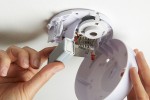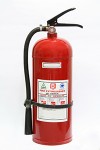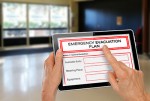 As we move into Fall (and Daylight Saving time will soon be upon us) it’s imperative to remember to change the batteries in our smoke detectors and carbon monoxide detectors. Did you know that three out of five home fire deaths result from fires in properties without working smoke alarms and that more than one-third (38 percent) of home fire deaths result from fires in which no smoke alarms are present. The risk of dying in a home fire is cut in half in homes with working smoke alarms.
As we move into Fall (and Daylight Saving time will soon be upon us) it’s imperative to remember to change the batteries in our smoke detectors and carbon monoxide detectors. Did you know that three out of five home fire deaths result from fires in properties without working smoke alarms and that more than one-third (38 percent) of home fire deaths result from fires in which no smoke alarms are present. The risk of dying in a home fire is cut in half in homes with working smoke alarms.
 Fire extinguishers are required in the workplace, but fire extinguishers are also beneficial to have in the home. A properly charged, ready-to-go fire extinguisher can be the difference between a bad situation and catastrophic loss! At home, fire extinguishers should be placed within close proximity to any open flame source and large electrical service. A good multi-purpose extinguisher should fulfill all your needs; it will work on all types of fires, including ordinary combustibles, chemical fires, and electrical fires.
Fire extinguishers are required in the workplace, but fire extinguishers are also beneficial to have in the home. A properly charged, ready-to-go fire extinguisher can be the difference between a bad situation and catastrophic loss! At home, fire extinguishers should be placed within close proximity to any open flame source and large electrical service. A good multi-purpose extinguisher should fulfill all your needs; it will work on all types of fires, including ordinary combustibles, chemical fires, and electrical fires.
 Not only is safety about having the right tools, but having a good plan. At work and at home, a plan should be in place for what to do when an emergency occurs. Emergency Action Plans should include maps or floor plans of your work area or your home so that escape routes are clearly identified. In the event of your main escape route being blocked, you should always have an evacuation backup plan. Once evacuated, you will need to know what to do, where to go, and any additional procedures to follow. Employees and family members alike must be aware of the plan and how to adapt to obstructions. Best practices identify that a good place for everyone to meet is in front of the home or business where you will be visible to incoming, responding units.
Not only is safety about having the right tools, but having a good plan. At work and at home, a plan should be in place for what to do when an emergency occurs. Emergency Action Plans should include maps or floor plans of your work area or your home so that escape routes are clearly identified. In the event of your main escape route being blocked, you should always have an evacuation backup plan. Once evacuated, you will need to know what to do, where to go, and any additional procedures to follow. Employees and family members alike must be aware of the plan and how to adapt to obstructions. Best practices identify that a good place for everyone to meet is in front of the home or business where you will be visible to incoming, responding units.
Fire Extinguishers
Extinguishers should be in plain view and properly charged.
To use a fire extinguisher, remember the acronym PASS.
P – Pull the pin from the handle.
A – Aim the nozzle at the base of the fire from approximately 5 feet away.
S – Squeeze the handle securely.
S – Sweep the nozzle from side to side covering all of the fire surface area.
When using a fire extinguisher, always face the fire so that your back is to the door,
which is your escape route. The ability to escape should be identified early and if it
is jeopardized for any reason, the responder should evacuate the area.
